and the distribution of digital products.
DM Television
Social media competitor analysis: Template + guide for 2024
How do you stay ahead of the competition and win on social media? Start with a social media competitive analysis.
It will tell you how you stack up against others in your industry, and surface new opportunities as well as potential threats.
This guide will teach you how to analyze — and learn from — competitor performance. We’ll also list the best social media competitive analysis tools and give you a free template to help you get started.
More of a visual learner? Check out our video to find out how to perform a competitive analysis on social media in just three steps:
What is a social media competitor analysis?A social media competitor analysis is an analysis of your competition on social media to find out what their strengths and weaknesses are, and how those strengths and weaknesses compare to your own.
It’s a process of benchmarking your own results against the heavy-hitters in your industry, so you can identify opportunities for growth as well as strategies that aren’t performing as well as they should.
A social media competitive analysis, specifically, will help you:
- Identify who your competitors are on social media
- Know which social media platforms they’re on
- Know how they’re using those platforms
- Understand how well their social and content strategies are working
- Benchmark your social results against the competition
- Identify social threats to your business
- Find gaps in your own social presence
Create. Schedule. Publish. Engage. Measure. Win.
Free 30-Day Trial The benefits of running a competitor analysis on social mediaLearning about your competitors is not the only reason to do a competitor analysis on social media. It will also give you deeper insights into your own business and your audience (which likely overlaps with your competitors’ audiences).
Here are some surprising insights a social media competitive analysis can give you:
- Performance benchmarks for your own business, such as average followers, engagement rates, and share of voice
- Ideas for the best times to post on social media (since your audience is likely online at a similar time)
- An understanding of the potential customer pain points
- New (and better) ideas for content that may resonate with your audience (or that, conversely, does NOT resonate with your audience, and which you might want to avoid)
- An understanding of how to communicate with your audience on certain platforms (i.e., casually or formally)
- Ideas for ways to differentiate your brand
- And more!
Ultimately, a social media competitive analysis will give you as much as you put into it. You may choose to do a one-off social media competitor report or hire someone on your team whose sole job it would be to keep track of your competitors. Most businesses do something in-between: a quarterly or monthly competitor analysis report.
Whatever level of analysis you choose, the insights will be invaluable.
How to do a social media competitor analysis in 4 stepsBefore you start, download this free social media competitor analysis template to keep track of your efforts.
Bonus: Get a free, customizable competitive analysis template to easily size up the competition and identify opportunities for your brand to pull ahead.
Step 1. Find your competitors Identify your competitive keywordsYou probably already know some of the keywords your business is trying to rank for in the search engines. For example, if you work for a Manhattan-based hotel, you’re likely focused on keywords such as “New York hotels,” and “best places to stay in Manhattan.”
But if your property is a boutique hotel with evening wine tastings and local art, you’re not necessarily competing directly with the Holiday Inn. Having a thorough understanding of keywords relevant to your product offering will help you develop a clear picture of who you’re really competing against online.
The Google Adwords Keyword Planner is a great place to identify the keywords most relevant to your brand. Even if you don’t advertise with Google Adwords, this tool is free to use.
To start, use the tool to analyze your website. You’ll get a list of relevant keywords, along with the average monthly searches and estimated level of competition.

Or, you can enter your known target keywords into the tool. Again, you’ll get a list of related keywords with data on search volume and competition. Use these related keywords to help you narrow your definition of your competitors, so you can make sure you’re analyzing businesses that are truly competing with your own.
Check who’s ranking for those keywords in GoogleChoose the top five or 10 keywords that have the most relevance to your business, and plug them into Google. You’ll soon get a sense of who your top competition is online.
Pay special attention to the brands in your industry that are paying for Google ads to get their names above the organic search results, as they’re putting their money where their marketing ambitions are. Even if they don’t have great organic search rankings (yet), it’s worth checking out how they’re performing on social media.
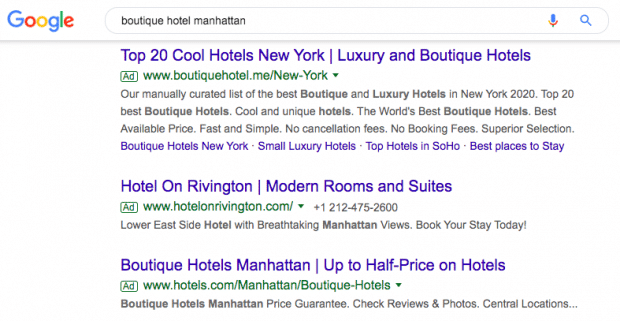
Click through to the websites of any brands that appear to be potential competitors. Most businesses link to their social channels in the header or the footer of their website. Enter the links to their social profiles in your competitive analysis spreadsheet.
Check who appears in social searches for those keywordsThe brands that rank for your keywords in Google are not necessarily the same ones that rank well within the social networks themselves. Since this is a social media competitive analysis, you need to see who comes up tops in social search results, too.
For example, head to Instagram and enter your keyword in the search box. Then, browse the “For you” feed and take note of the brands that show up there.

You may have heard that TikTok has become Gen Z’s favorite search engine. So, if you’re trying to reach a younger audience, make sure to run a search there too.
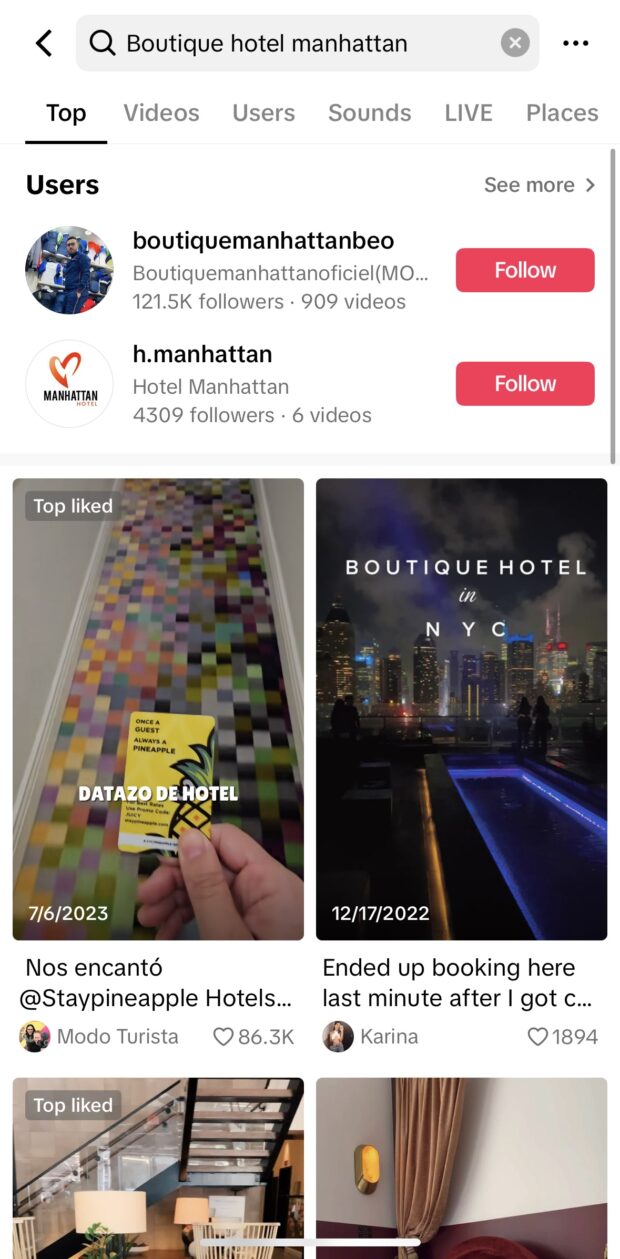
For more tips on searching the various social networks, check out our post on the best ways to research online.
Find out what similar brands your audience followsFacebook Audience Insights and X (Twitter) Analytics can give you some good insights into which other brands your audience follows on these social networks. If these brands are similar to yours, it’s worth considering them as potential competitors.
To find which brands your audience follows on Facebook:
- Open Facebook Audience Insights
- Scroll down to Top pages
You may find that none of the Pages identified are relevant to your industry, but if they are, add them to your list of competitors.
On X, rather than checking on your whole audience, you can check to see who your top followers are connected to.
- Open X Analytics.
- Scroll down to each of your Top Followers for the last several months
- Click View profile for each Top Follower
- Click Following on their profile to see the full list of accounts they’re following, or click Tweets & replies to see which accounts they interact with
By now you’ve got a huge list of potential direct and indirect competitors — far more than you could reasonably include in a thorough competitive analysis. It’s time to narrow down your list to the top three to five brands who you are most closely competing with on social media. Choose the brands that have the closest fit to your target markets.
Step 2. Gather intelNow that you know who your competition is, you need to learn what they’re up to on social media.
Click through to the social networks of each of the brands you’ve identified as top competitors. As mentioned above, you can usually find these links in the header or footer of their website. In your social media competitive analysis template, make note of the following:
- What social networks are they on?
- How large is their following and how fast is it growing?
- Who are their top followers?
- How often do they post?
- What is their engagement rate?
- What is their social share of voice?
- What hashtags do they use most often?
- How many hashtags do they use?
You can find much of this information about your competitors just by clicking around their social profiles. For more streamlined data gathering, check out the analytics tools mentioned below.
Don’t forget to track all of these things for your own social channels as well. This will help you with your analysis in the next step.
Step 3. Do a SWOT analysisNow that you’ve gathered all that data, it’s time to analyze it in a way that helps you understand where you stand compared to the competition. As part of this analysis, you’ll also look for potential ways to improve your social marketing strategy, and potential hazards to watch out for along the way.
A SWOT analysis is a great tool to help you think clearly about all of this information. In a SWOT analysis, you take a hard look at your business and the competition to identify: strengths, weaknesses, opportunities, and threats.
The important thing to know is that strengths and weaknesses involve factors internal to your brand. Basically, these are things you’re doing right, and areas where you could stand to improve.
Opportunities and threats are based on external factors: things happening in your competitive environment that you need to be aware of.
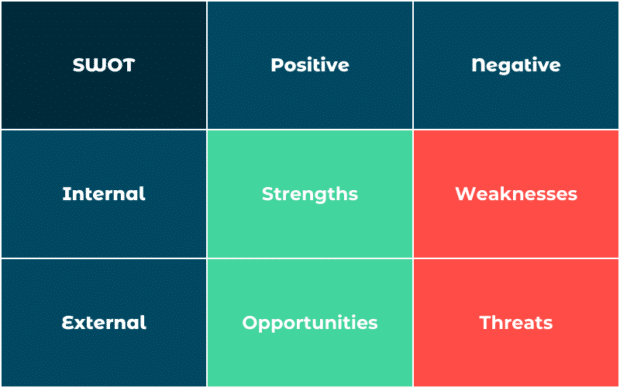
Here are some items to list in each quadrant of the SWOT template.
StrengthsList metrics for which your numbers are higher than the competition. This is your competitive advantage!
WeaknessesList metrics for which your numbers are lagging behind the competition. These are areas you’ll want to focus on improving through testing and tweaks to your social media strategic plans.
Keep in mind that you could have both strengths and weaknesses for each social network. For example, maybe your Facebook follower count is higher than your competitors, but they have better follower growth. Or maybe you have fewer Instagram followers but higher engagement.
Get quite specific here, because these distinctions will help you identify your opportunities and threats.
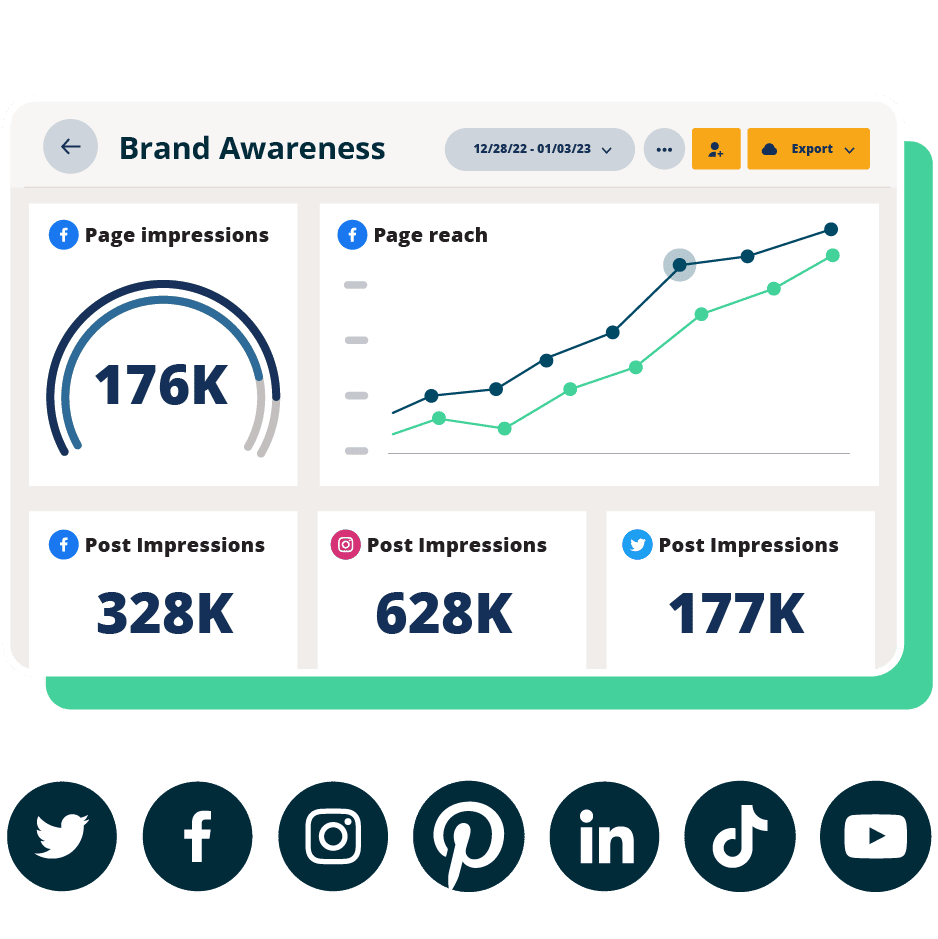 #1 Analytics Tool for Growth
#1 Analytics Tool for Growth
Beautiful reports. Clear data. Actionable insights to help you grow faster.
Start free 30-day trial OpportunitiesNow that you can see at a glance where you stand compared to the competition, you can identify potential opportunities to take advantage of.
These opportunities might be areas where you think you could improve compared to your competition based on information you’ve already gathered, or they could be based on anticipated or recent changes in the social media world.
ThreatsLike opportunities, threats come from outside your organization. To get a keen sense of upcoming threats, take a good look at numbers related to growth, or anything that signifies change over time.
For example, a competitor that is small but has a high follower growth rate might present a bigger threat that a large competitor with stagnant growth.
This is another area where you need to keep an eye on the broader industry for upcoming changes that could affect your position compared to your competitors. The Hootsuite State of Digital Reports are a great source of industry information to consider.
Step 4. Set up social media monitoring to track competitors on an ongoing basisYou’ll need to revisit your social media competitive analysis regularly to keep it current. Make this a regular part of your quarterly or annual reporting and review. That means you’ll need a constant supply of up-to-date information.
Putting a solid social media monitoring strategy in place will equip you with that real-time data to incorporate in your next analysis. This is an especially useful strategy for identifying potential opportunities and threats.
We’ll go over some tools you can use for social media monitoring below. Basically, it’s all about being aware of social conversations involving your brand (and product or service), your competitors, and your industry.
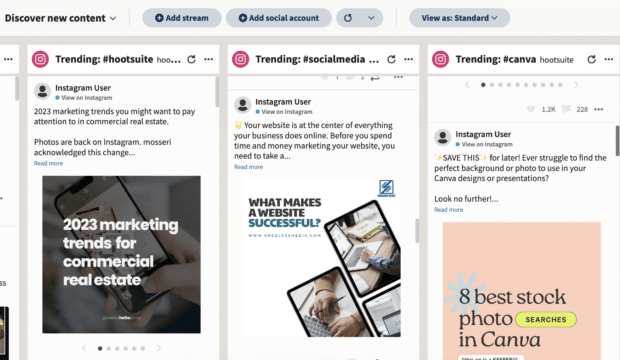 Try for free for 30 days
Try for free for 30 days
Record any important information or events you uncover through social media monitoring in the Notes column of your competitive analysis template, and incorporate them into your revised opportunities and threats during your next review.
8 top social media competitor analysis toolsIn step 2, we talked about how to gather intelligence directly from the social networks. Here are some of the best social media competitive analysis tools that will do the digging for you.
1. Competitive Analysis in Hootsuite AnalyticsWhether you’re running a full competitive analysis or just browsing for inspiration, look no further. Hootsuite Analytics does Instagram, Facebook, and X (formerly Twitter) competitive analysis for you. You can track up to 20 competitor profiles per network, and get a clear view of your strengths and weaknesses — plus actionable insights on the top posts, hashtags, and types of content in your niche.
Follow these 4 simple steps to analyze competitors with Hootsuite:
- Sign in to your Hootsuite account and pick Analytics from the main menu on the left side of the dashboard.
- Then, click on Competitive analysis in the Benchmarking section.
- At the top of the page, use the dropdown list of your social profiles to select the one you want to compare to competitors.
- Then, pick the competitors you want to measure your social media performance against. To do that, go into the second dropdown list and check the boxes next to the competitors you want to view. To add competitors, click Manage competitors at the bottom of the dropdown box.
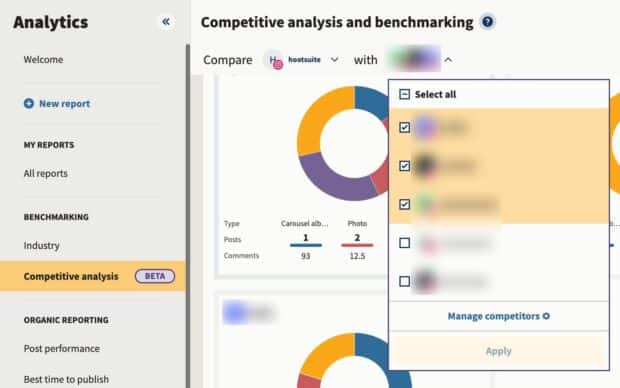
Type the name of a competitor into the search bar and select the correct profile from the dropdown list. Depending on your Hootsuite plan, you can add between 2 and 20 social accounts per network (Facebook, Instagram, and X) to your watchlist.

And that’s it! Now you can browse several competitive reports, including:
Overview, where you can see the number of posts you and your competitors posted in the selected timeframe (that can be adjusted in the top right corner of the dashboard) as well as every account’s posting frequency, average engagement, number of followers, and audience growth rate.
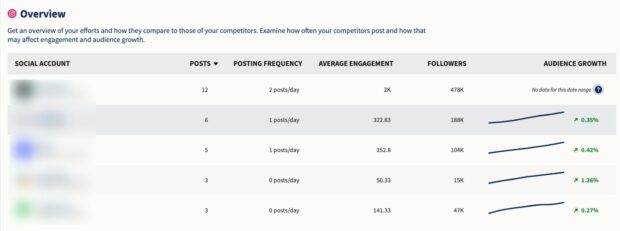
Post performance, where you can review your and your competitors’ top posts and sort results by likes, comments, and engagement — and quickly fetch inspiration for what to publish next.
Performance by post type, where you can find out what types of posts — photos, videos, carousels, or Reels — are most popular with each brand’s audience. Results can be sorted to show which post types get the most likes, comments, or engagement.
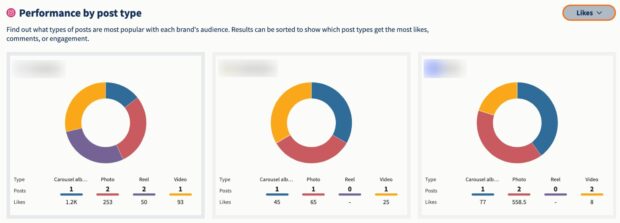
Post performance (by comments, likes, or estimated engagement), where you can see how you and your competitors did every day within the specified timeframe — all in one easy-to-read graph. You can drill down results by post type, or stick to the overall view.

Trending hashtags… which speaks for itself.

Post length, where you can find out how many characters and hashtags, on average, your competitors use in their posts.

Learn more about competitive analysis in Hootsuite Analytics. The feature is available in all paid plans.
2. Industry benchmarking in Hootsuite AnalyticsIf you want to see how your results shape up against your industry as a whole (rather than individual competitors), this is the perfect tool for you.
With Hootsuite’s social media benchmarking, you can find out how others in your industry are doing on social and compare your results with just a few clicks.
To get industry benchmarks, follow these steps:
- Sign in to your Hootsuite dashboard and head to Analytics.
- In the menu on the left side of the screen, scroll to Benchmarking and click Industry.
- Pick an industry that best describes your business.
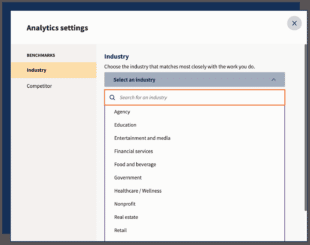
That’s it! Now you can see how your results compare to average performance stats within your industry. You can set up custom timeframes, switch between networks — Instagram, Facebook, X, LinkedIn, and TikTok — and look up benchmarks for the following metrics:
- Profile impressions
- Profile reach
- Followers
- Audience growth rate
- Engagement rate
- Video plays
- Posting frequency
- Clicks
- Shares
… and more.
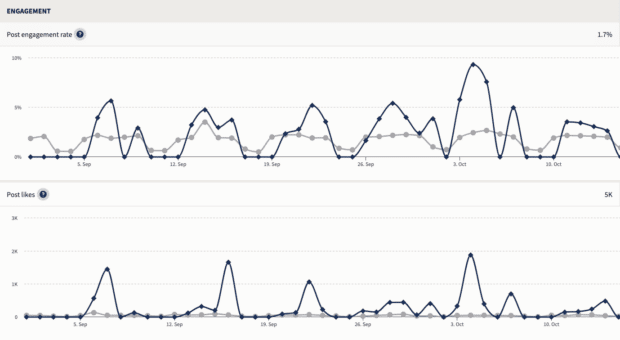
You will also find resources to improve your performance right in the summary section:

And, if you need to present your results to your team, boss, or other stakeholders, you can easily download your comparison report as a PDF file.
3. Hootsuite Listening BasicsEvery Hootsuite plan comes with Listening Basics, a powerful tool that allows you to track what people are saying about you, your top competitors, and your products —up to two keywords tracking anything at all over the last seven days—all from one easy-to-use dashboard.

And if you want to take social listening to the next level, our upgraded listening tools (powered by Talkwalker) can show you sentiment over time, top influencers in your space, audience demographics, and much more.
Actually, speaking of Talkwalker…
4. TalkwalkerTalkwalker is primarily known as a social listening tool with a huge library of insights—competitive or otherwise—from over 150 million sources, including blogs, forums, videos, news, reviews, and social networks.
Use it if you want to spy on your competitors beyond social media and keep tabs on what the entire industry is saying. It’s great for high-level overviews as well as detailed analyses.
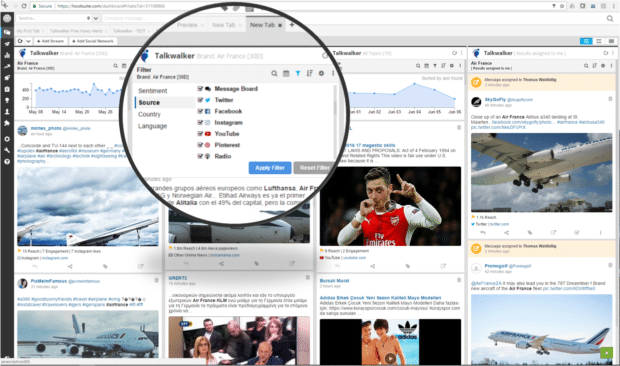 5. Synapview
5. Synapview
Ready to go beyond social media competitive analysis? Synapview is an app that lets you monitor competitors and hashtags on Reddit and blogs too.
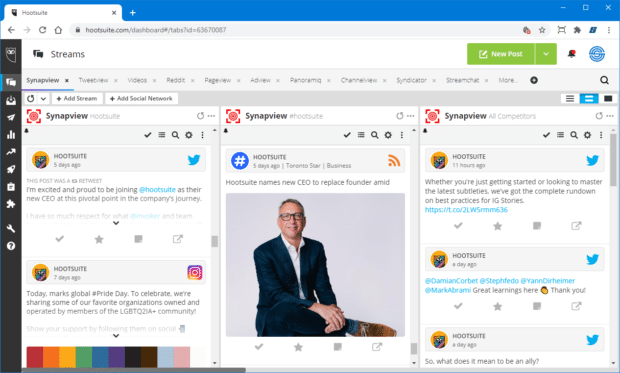 6. Mentionlytics
6. Mentionlytics
Mentionlytics is a social media monitoring tool that is also great for doing a social media competitive analysis. You can discover everything that is being said about your brand, your competitors, or any keyword on X, Instagram, Facebook, Youtube, Pinterest and all web sources (news, blogs, etc.).
Plus, it has a handy “sentiment analysis” feature, so you can see not only what is being said about your competitors but how it is being said.
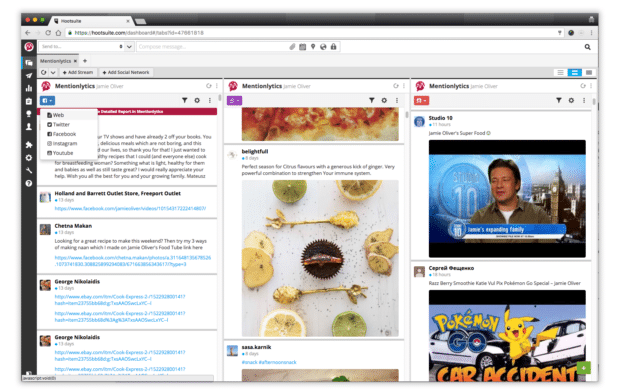
PS: Mentionlytics integrates with Hootsuite so you can see everything it pulls in your Streams.
7. BrandwatchBrandwatch offers some powerful competitive analysis tools. One of the most important is its easy-to-understand graphic showing your brand’s social share of voice.
Social share of voice is a measure of how much people talk about your brand online compared to how much they talk about your competitors. This is one of the metrics you should track in your social media competitive analysis template.
 8. Sprout Social
8. Sprout Social
Sprout Social is a comprehensive social media management tool that offers some competitive analysis features. Sprout’s tools help users track and measure growth across competitors’ social accounts and easily check how those stats compare to their own. A word cloud solution that surfaces trending topics and keywords is also available.
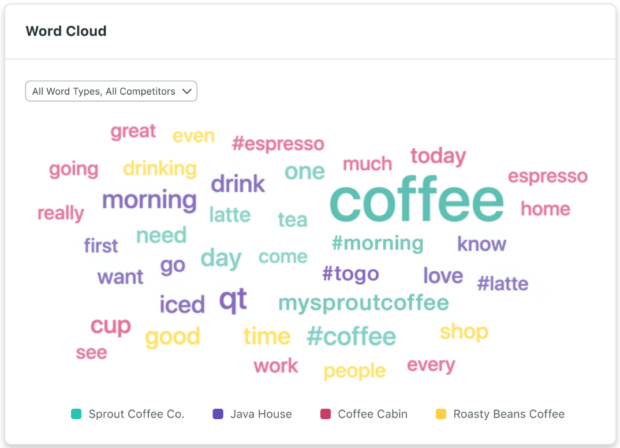
Source: Sprout Social
Check out our detailed side-by-side comparison to see how Sprout Social stacks up against Hootsuite.
Free social media competitor analysis templateYou could create your own spreadsheet to keep track of all the information you gather during your social media competitive analysis.
But if you’d rather get straight to work collecting data and putting it to use, download our free social media competitive analysis template and just start plugging in the information you collect. There’s a tab for your SWOT analysis, too.
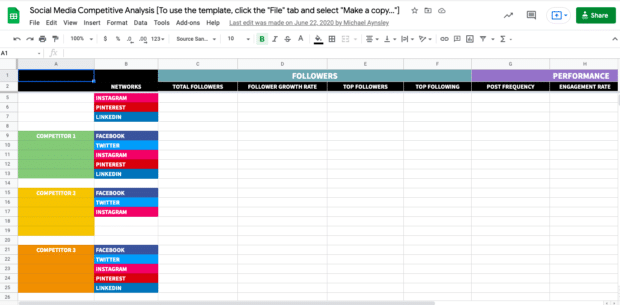
Bonus: Get a free, customizable competitive analysis template to easily size up the competition and identify opportunities for your brand to pull ahead.
Use Hootsuite to crush the competition on social media. Manage all your profiles, track competitors and relevant conversations, improve performance, and much more — all from one simple dashboard. Try it free today.
Get StartedThe post Social media competitor analysis: Template + guide for 2024 appeared first on Social Media Marketing & Management Dashboard.
- Home
- About Us
- Write For Us / Submit Content
- Advertising And Affiliates
- Feeds And Syndication
- Contact Us
- Login
- Privacy
All Rights Reserved. Copyright , Central Coast Communications, Inc.
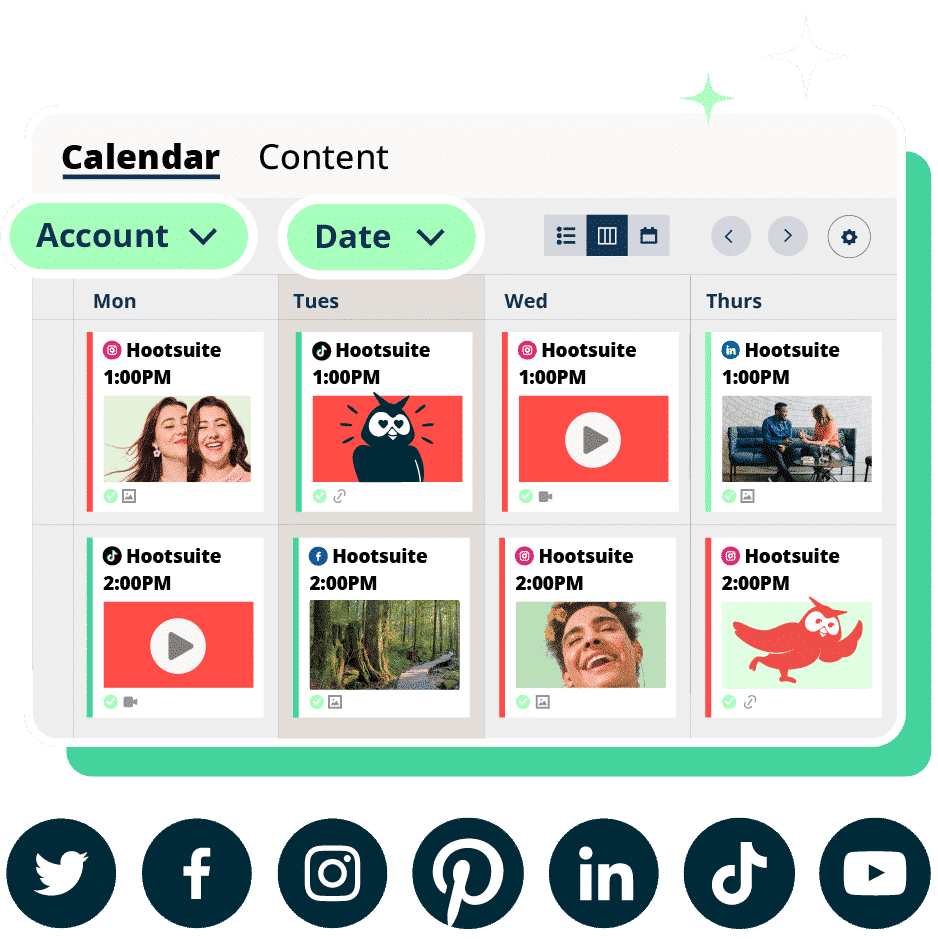 #1 Social Media Tool
#1 Social Media Tool